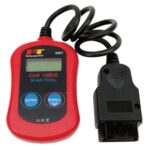What Does OBD-II Code P0805 Mean?
The diagnostic trouble code (DTC) P0805 is a generic powertrain code, which means it can occur in a wide range of vehicles manufactured from 1996 onwards that adhere to the OBD-II standard. Vehicle brands such as Dodge, Ford (including models like Focus and Fiesta), Smart, Land Rover, Chevrolet, Chrysler, Jeep, Mercedes, and Toyota are potentially affected. While P0805 is a generic code, the specific steps for diagnosis and repair can vary significantly depending on the vehicle’s year, make, model, and powertrain configuration.
Code P0805, along with related codes like P0806, P0807, P0808, P0809, and P080A, indicates a problem within the clutch position sensor circuit. This circuit is typically monitored by either the Powertrain Control Module (PCM) or the Transmission Control Module (TCM), depending on the vehicle’s design.
The primary function of the clutch position sensor circuit is to accurately determine the clutch’s status in vehicles equipped with a manual transmission. It achieves this by monitoring the output voltage of the clutch position sensor. This voltage signal changes based on whether the clutch is engaged or disengaged, allowing the vehicle’s computer to know the clutch pedal’s position.
In most vehicles, the clutch position sensor is a simple on/off switch. It’s usually located near the clutch pedal, often mounted on the pedal support bracket. Typically, one side of the switch receives a constant voltage supply. When the clutch pedal is depressed (clutch engaged), the switch contacts close, allowing voltage to flow through to the starter or starter solenoid circuit. This fundamental circuit acts as a safety mechanism, preventing the engine from starting unless the clutch is engaged (pedal depressed).
When the PCM or TCM detects an abnormal voltage reading or resistance level within the clutch position sensor circuit, it interprets this as a malfunction. As a result, the P0805 code is triggered, and the check engine light or transmission warning light on the dashboard will illuminate to alert the driver of the issue.
A typical clutch position sensor:
How Severe is DTC P0805?
The severity of a P0805 code is generally considered moderate. However, it can escalate to a severe issue if the vehicle becomes capable of starting with the clutch disengaged. This presents a significant safety hazard, as the vehicle could unexpectedly move when started in gear, potentially causing accidents or injuries. Therefore, addressing a P0805 code promptly is crucial for safety and vehicle operability.
Common Symptoms of a P0805 Code
When your vehicle logs a P0805 trouble code, you might observe several symptoms, including:
- Engine Won’t Start: The most common symptom is the engine failing to start. This is because the system may not recognize that the clutch is engaged, preventing the starter from activating.
- Engine Starts Without Clutch Engagement: Conversely, in some cases, the engine might start even when the clutch is not engaged. This indicates a failure in the safety mechanism designed to prevent starting in gear.
- Transmission Warning Light is On: Depending on the vehicle, a transmission warning light might illuminate on the dashboard.
- Check Engine Light is Illuminated: The check engine light will typically come on, signaling a detected issue within the engine management system.
Common Causes of Code P0805
Several factors can lead to a P0805 code. Identifying the root cause is essential for effective repair. Common culprits include:
- Defective Clutch Position Sensor: The sensor itself might be faulty due to wear, electrical damage, or internal failure. This is often the primary suspect.
- Faulty or Damaged Wiring: Wires in the clutch position sensor circuit can become damaged due to chafing, age, heat, or rodent damage. This can lead to shorts, opens, or increased resistance in the circuit.
- Loose or Defective Control Module Ground Strap: A poor or missing ground connection for the PCM or TCM can disrupt sensor signals and cause false readings, triggering a P0805 code.
- Corroded, Damaged, or Loose Connectors: Electrical connectors in the clutch position sensor circuit are exposed to the elements and engine bay heat, making them susceptible to corrosion, damage, or becoming loose. This can impede electrical flow and cause circuit malfunctions.
- Defective Fuse or Fusible Link (If Applicable): Some vehicles incorporate fuses or fusible links in the clutch position sensor circuit to protect it from overloads. A blown fuse or link can disable the circuit and trigger a P0805 code.
- Defective PCM or TCM: In rare cases, the PCM or TCM itself might be faulty. However, this is usually diagnosed after ruling out all other potential causes, as control module failures are less frequent than sensor or wiring issues.
Troubleshooting Steps for P0805
Diagnosing a P0805 code requires a systematic approach. Here are step-by-step troubleshooting procedures:
Preliminary Steps
-
Check for Technical Service Bulletins (TSBs): Always begin by consulting Technical Service Bulletins (TSBs) for your specific vehicle’s year, make, and model. TSBs are issued by manufacturers to address known issues and can provide valuable shortcuts in diagnosis, potentially saving considerable time.
-
Visual Inspection: Locate the clutch position sensor switch, typically found near the clutch pedal. Perform a thorough visual inspection, looking for any obvious physical damage to the sensor or the surrounding wiring.
-
Wiring Inspection: Carefully examine the wiring associated with the clutch position sensor circuit. Look for signs of damage such as:
- Scraping or Rubbing: Wires rubbing against metal parts can wear through the insulation.
- Bare Wires: Exposed wires can short circuit against ground or other wires.
- Burn Spots: Overheating can cause burn spots and damage to the wiring insulation.
-
Connector Inspection: Inspect the electrical connectors and connections within the clutch position sensor circuit. Check for:
- Security: Ensure connectors are firmly seated and locked.
- Corrosion: Look for green or white powdery deposits on connector pins, indicating corrosion.
- Damaged Pins: Bent or broken connector pins can disrupt electrical contact.
This inspection should include all connectors associated with the clutch position sensor switch, PCM, starter, and starter solenoid.
-
Fuse Check: Consult your vehicle’s wiring diagrams and technical data to determine if a fuse or fusible link is part of the clutch position sensor circuit. If so, check the fuse for continuity and replace it if blown.
Advanced Diagnostic Steps
For more in-depth diagnosis, advanced steps are necessary and require specialized equipment and knowledge. These procedures are vehicle-specific and rely on accurate technical information.
-
Voltage Checks: Use a digital multimeter to perform voltage checks.
- Clutch Disengaged (Pedal Up): With the clutch pedal in the resting position (disengaged), there should be approximately 12 volts on one side of the clutch position sensor switch.
- Clutch Engaged (Pedal Down): When the clutch pedal is fully depressed (engaged), voltage should be present on both sides of the sensor switch, indicating that the switch is closing and allowing current to flow through.
- Starter/Solenoid Voltage: Verify that voltage is reaching the starter solenoid or starter when the clutch is engaged (depending on the circuit configuration).
-
Continuity Testing: If voltage checks indicate a lack of power or ground, perform continuity tests to assess the integrity of the wiring, connectors, and components.
- Power Off: Always disconnect power from the circuit before performing continuity tests to prevent damage to your multimeter or the vehicle’s electrical system.
- Resistance Measurement: Use the multimeter to measure resistance (ohms) in the wiring and connections. Healthy wiring and connections should exhibit near-zero ohms of resistance.
- Open or Short Circuit Detection: High resistance or no continuity indicates a fault in the wiring, such as an open circuit (break in the wire) or a short circuit (unintended path to ground). These wiring issues must be repaired or replaced.
- Ground Strap Continuity: Perform a continuity test between the PCM or TCM ground pin and the vehicle’s chassis ground. This verifies the integrity of ground straps and ground wires. Resistance here indicates a loose connection or corrosion.
Common Repairs for a P0805 Code
Based on the diagnosis, typical repairs for a P0805 code include:
- Cleaning Corrosion from Connectors: Thoroughly clean corroded connectors with electrical contact cleaner and a wire brush. Apply dielectric grease to prevent future corrosion.
- Repairing or Replacing Faulty Wiring: Repair damaged wiring by splicing in new wire sections or replacing entire wiring harnesses if necessary. Ensure proper soldering and insulation of repairs.
- Replacing Blown Fuse or Fusible Link: Replace any blown fuses or fusible links with the correct amperage rating. Investigate the cause of the blown fuse to prevent recurrence.
- Repairing or Replacing Faulty Ground Straps: Ensure ground straps are securely connected and free of corrosion. Replace damaged or corroded ground straps.
- Replacing Defective Clutch Position Sensor: Replace the clutch position sensor if it is diagnosed as faulty after testing.
- Flashing or Replacing the PCM or TCM: In rare cases, if the PCM or TCM is diagnosed as the root cause, it may require reprogramming (flashing) or replacement.
Common Mistakes to Avoid
A frequent mistake when addressing a P0805 code is misdiagnosis, leading to unnecessary replacements. Avoid these pitfalls:
- Premature Starter/Solenoid Replacement: Do not assume the starter or starter solenoid is the problem without first thoroughly testing the clutch position sensor circuit. Replacing these components when the issue lies elsewhere is a common and costly error.
- Control Module Replacement Without Proper Diagnosis: Replacing the PCM or TCM should be the absolute last resort. Ensure all other potential causes, particularly the clutch position sensor and wiring, have been rigorously ruled out before considering control module replacement.
By following a systematic diagnostic approach and understanding the common causes and symptoms of a P0805 code, you can effectively troubleshoot and repair clutch position sensor circuit issues. Remember to always consult the specific technical data and service bulletins for your vehicle to ensure accurate diagnosis and repair procedures.
Disclaimer: This information is intended for informational purposes only and should not be considered professional repair advice. We are not liable for any actions taken on your vehicle based on this information. Always prioritize consulting official service manuals and qualified technicians for vehicle repairs.


